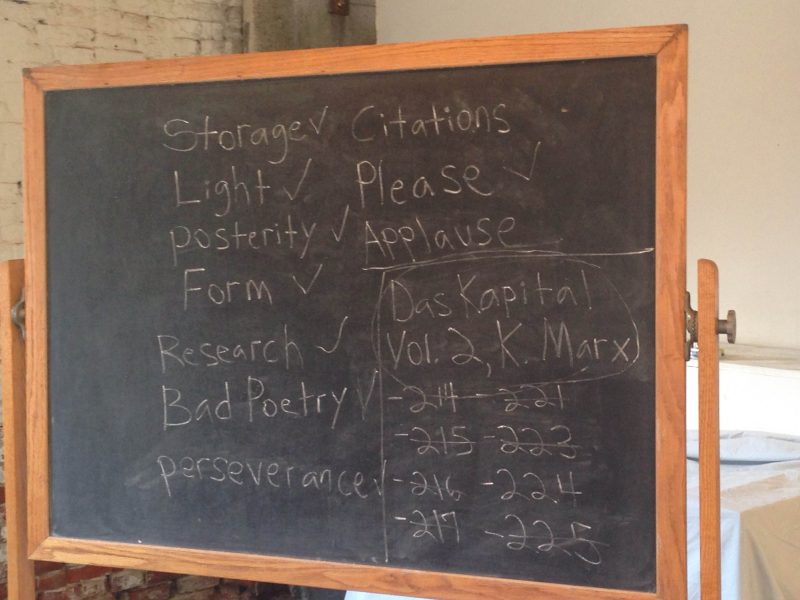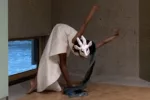
On August 20, 2016, I attended “Gallery Copy,” a performance by the artist Jim Grilli at Little Berlin project space, “The Annex”. The performance was a component—I would say the most crucial one—of a set of displayed quasi-industrial objects (such as a roll of felt-like fabric and metal chairs) and mounted hand-written texts that Grilli had displayed in the project space and that were meant to accompany the performance. In this review, I focus on the performance, paying particular attention to what I take to be its most salient conceptual aspects.
Standing by a black free-standing chalkboard and speaking into a microphone, Grilli’s performance consisted of the artist reading pre-scripted texts and making small interventions on the chalkboard for approximately thirty minutes. Structuring the performance were three interrelated parts, each one focused on a particular aspect of the content of the piece. It is the narrative that was formed from these parts that reveals the content of Grilli’s artistic concerns.
The first part was comprised of a reading of what appeared to be a relatively abstract monologue of a fictional artist’s negotiation of the removal and storage of his/her work; this reading was accompanied by an interaction with a blackboard on which a number of terms such as “posterity,” “perseverance,” and “applause” were consecutively ticked when Grilli came to the adequate moment in the narrative. The second part consisted of a reading of a prose-poetry text. The text was a story that appeared to depict an individual’s reflections on the possible arrival of a lover or friend. The third and final part of Grilli’s performance returned to the first reading but with a significant difference of emphasis—the fictional artist no longer recounts his/her experience with a removal company but reflects on the experience itself via reference to Karl Marx’s Capital.
What was going on in Grilli’s performance? At first blush, the performance was difficult to comprehend. Its difficulty, however, was not due to any esoteric aspect but, rather, because the subject Grilli tackled (at least as far as I understood the work) is by definition hard to grasp. I take the motivating premise of the performance to be the attempt to provide some kind of formal narrative to the experience of the contemporary alienation of the figure of the artist under the conditions of capitalism. The difficulty Grilli brings into relief in his performance is how to adequately (or inadequately) represent this alienation in artistic form. The key to understand what I mean by this is located in the first part of Grilli’s performance.
Alienation from the artwork
The first part consisted of what an artist does when they have artwork that is no longer displayed in a gallery, which is to say, when art is taken out of its context within a privileged space in which objects are immediately recognized as ‘art.’ Outside of exhibitions and the purchase of works by collectors, artworks need to be managed in a similar manner to household tasks. The conditions of post-exhibition storage reveal the demystified character of artworks. In other words, artworks are not rarefied objects but are simply ‘stuff,’ ‘junk,’ or ‘paraphernalia.’
What happens in this transition from art to stuff is a twofold process of abstraction. First, the artist is abstracted from the product of their own creative activity. Second, art itself is abstracted into a vague, general expression of thing-hood via the processes of storage. By abstraction I do not mean an artistic mannerism in which forms are created without any referent. Rather, abstraction refers to a material process that extracts and distills complex social relations into isolated and one-dimensional states.
In Grilli’s performance, the twofold abstraction of artist and artwork is underscored by the fictional artist’s attempt to negotiate what to do with the objects to be stored and the pantomimic conversation staged between artist and art-handling company employee. It was further reinforced by a strange list of words that were written on a blackboard that stood beside Grilli.
At specific moments of the narrative, Grilli drew a ‘tick’ beside the words, at once reflecting the content of his narrative and somehow robotically performing a series of mundane, organizational activities that secure the smooth transaction of a task such as storing art objects. This dimension of the performance divided the narrative into a series of isolatable units, units that one could strike off as if on a checklist. In other words, the narrative not only depicted the story of an artist’s abstraction from their artwork and the conversion of art into ‘stuff,’ but it was itself subjected to a process of abstraction by way of its reduction to divided units (words) of signification.
In some sense, then, we begin to unravel Grilli’s reflections on the state of the alienation of artists under the conditions of capitalist abstraction. Artistic activity is subsumed under the conditions of a mode of life that reduces all activities to measurable units of meaning. That is to say, artistic activity is not free of external, determinate factors (such as removal-storage agencies) but, rather, is mediated by them.
Home is hell
If the first part of Grilli’s performance was a presentation of the twofold abstraction of an artist’s ineluctable distancing from their own product and the abstraction of art itself by ostensibly external realities, the second part was, at an immediate level, significantly less hypothetical.
The opening narrative is broken by the reading of a fictional letter that appears to be composed by an individual waiting in anticipation of the arrival of a lover or friend (the relationship between the two as portrayed by the letter-writer is not clear). In direct distinction to the rather mechanistic quality of the first narrative, the second story was lyrically animated by a relish for the details of domestic life in what seems to be a countryside dwelling.
The letter Grilli read was replete with minute details of the colors, smells, and sounds of each individual component of a house and its surroundings. The first character makes note of the bliss of simple living, but is also careful not to paint too much of an enchanted picture as even the daily difficulties are set out in proverbial candor (floors need to be cleaned, dishes need to be tidied away, etc.).
The epistolary form of the second part of the performance could be said to reflect the seemingly non-abstract and non-alienated representation of everyday life (we write letter-like messages all the time). But was this the case in Grilli’s performance? There was something alienating about the excessive fascination with detail in the second narrative. The letter writer was somehow obsessively fixated on all the external minutiae of what is, at the end of the day, simple country living. In other words, the latter is stripped of its simplicity and we enter a complex matrix of analyzed and inspected particularities. Simple home life appears as a kind of hell of passionate attachment to inanimate things (potentially holding in abeyance deeper psychic problems, temptations, and experiences).
If the fictional artist in the first story is negotiating how to come to terms with the fact that, at bottom, they are abstracted from the very product of their artistic work, then the letter-writer of the second narrative is trying to somehow find themselves through a neurotic, ritualistic recollection of every detail of their daily labor (there is an element of the “Ithaca” chapter of James Joyce’s Ulysses in the structure and form of Grilli’s letter).
At the end of the letter, we are left with no sense of what happened to the relationship of the characters. That said, I was left with the impression that the fictional character that composed the letter was writing to no one other than himself or herself; in other words, they were the addressee of their own message. If this is indeed the case, then the detailed recollection of daily life not only discloses alienation as a symptom that emerges because of the oceanic abundance of particularity, but it also constitutes an internal division in the individual itself. A letter addressed to the one who composes it performs a kind of external manifestation of an internal division of the self. That is, an objectification of self-alienation.
The art object as stock
At the end of reading the letter, Grilli turns back to the first narrative. The story has changed; however; the fictional artist is no longer recounting the exchange with a removal-storage company employee, but is engaged in what seems to be a theoretical investigation of their experience of storing their work. The key to this theoretical engagement is Marx’s reflections on the “Costs of Storage” in the second volume of his Capital: A Critique of Political Economy.
In this section, the artist is no longer simply alienated from the product of their work, but has a stronger sense of what their work actually is at a given moment. Within the context of storing work, the art object is understood as ‘stock’ (at least this is what we are led to infer from Grilli’s reference). Grilli’s reference to the second volume of Capital was perhaps the less coherent part of the performance not least because it brought to the surface an extremely specific yet relatively under-discussed section of Marx’s massive work. For example, it was not clear how the stock form of the commodity (commodity stock) in the process of the costs of its circulation—which is Marx’s focus in the sections Grilli drew our attention to—functioned in relation to the narratives of the first and second parts, that is, in relation to the narration of the alienating consequences of abstraction.
A more general problem with references to texts such as Capital is the opportunistic alignment of artistic content with an ostensibly self-evident political topicality (this was one consequence of Isaac Julian’s project of “reading Capital” in the 2015 Venice Biennale). It did not strike me that the recourse to Marx was necessary in relation to the narrative Grilli was constructing. In other words, Grilli did not mobilize the text in any critical sense. Simply reading from passages gives only a de-contextualized patchwork of a text that needs a more dedicated reading.
(It must be said, however, that the focus on the processes of circulation is an interesting gesture. What happens to artworks when, for example, they are stored away? How do the costs of their movement from studio to gallery to museum affect the cost of artistic production and the dynamics of an art market?)
In the process of crystallization
Overall, Gilli’s performance articulated a complexity that was welcome and it did so within a project space that promises more interesting interventions. What was distinctive about the performance was its staging of the artist’s thought process in a moment of its development.
It strikes me that the connection of distinct sets of artistic production—the appropriation of everyday objects, reading performances, and the construction of prose-poetry—is yet to be crystallized both formally and conceptually by Grilli. I look forward to future iterations of his work and, more importantly, to further artistic investigations of complex issues such as experiences of artistic alienation, the effects of contemporary capitalist abstraction, and the possibility and/or impossibility of providing some kind of narrative to them.









